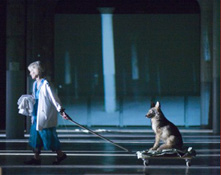- Joan Jonas
Infobox Artist
bgcolour = #6495ED
name = Joan Jonas

imagesize = 200px
caption = "The Shape, The Scent, The Feel of Things"
birthname =
birthdate = 1936
location =New York City ,New York
deathdate =
deathplace =
nationality = American
field =Video art ,Performance art ,Sculpture
training =
movement =Performance art
works =
patrons =
influenced by =
influenced =
awards =Born in 1936 in
New York City , Joan Jonas is a pioneer of video andperformance art and one of the most important female artists to emerge in the late 1960s and early 1970s.She began her career in New York City as a sculptor. By 1968 she moved into what was then leading edge territory: mixing performance with props and mediated images, situated outside in natural and/or industrial environments. In her early works, such as "Wind" (1968), Jonas filmed performers stiffly passing through the field of view against a wind that lent the choreography a psychological mystique. "Songdelay" (1973), filmed with both telephoto and wide angle lenses (which produce opposing extremes in depth of field) drew on Jonas' travels in Japan, where she saw groups of Noh performers clapping wood blocks and making angular movements.
Jonas’ video performances between 1972 and 1976 pared the cast to one actor, the artist herself performing in her New York loft as "Organic Honey", her seminal alter-ego invented as an “electronic erotic seductress,” whose doll-like visage seen reflected bits on camera explored the fragmented female image and women’s shifting roles. Drawings, costumes, masks, and interactions with the recorded image were effects that optically related to a doubling of perception and meaning. For Jonas, in "Organic Honey" and earlier performances, the mirror became a symbol of (self-) portraiture, representation, the body, and real vs. imaginary, while also sometimes adding an element of danger and a connection to the audience that was integral to the work.
In 1976 with "The Juniper Tree", Jonas arrived at a narrative structure from diverse literary sources, such as fairy tales, mythology, poetry, and folk songs, formalizing a highly complex, nonlinear method of presentation. Using a colorful theatrical set and recorded sound, "The Juniper Tree" retold a Grimm Brothers tale of an archetypal evil step mother and her family. In the 1990s, Jonas’ "My New Theater" series moved away from a dependence on her physical presence. The three pieces investigated, in sequence: a Cape Breton dancer and his local culture; a dog jumping through a hoop while Jonas draws a landscape; and finally, using stones, costumes, memory-laden objects, and her dog, a video about the act of performing.
In her installation/performance commissioned for "
Documenta 11", Lines in the Sand (2002), Jonas investigated themes of the self and the body in a performance installation based on the writer H.D.’s (Hilda Doolittle) epic poem “Helen in Egypt” (1951-55), which reworks the myth of Helen of Troy. Jonas sited many of her early performances at The Kitchen, including Funnel (1972) and the screening of Vertical Roll (1972).In "The Shape, The Scent, The Feel of Things", produced by
The Renaissance Society in 2004, Jonas draws on Aby Warburg's study of Hopi imagery. Jonas sees something of a parallel between herself and Warburg who compared diverse geographical and chronological cultures through an analysis of abstract imagery taken from their various artifacts. Drawing on sources ranging from Noh to Nordic theater, from the Brothers Grimm to Homer, Jonas extrapolates the magic of universal narratives from the most quotidian of circumstances so that she, as well as we, may become the heroes and heroines, victims and villains of the myth of self and origin.Jonas’ works were first performed in the 1960s and 70s for some of the most influential artists of her generation, including
Richard Serra ,Robert Smithson ,Dan Graham andLaurie Anderson . While she is widely known inEurope , her groundbreaking performances are lesser known in the United States, where as critic Douglas Crimp wrote of her work in 1983, “the rupture that is effected in modernist practices has subsequently been repressed, smoothed over.” Yet, in restaging early and recent works, Jonas continues to find new layers of meanings in themes and questions of gender and identity that have fueled her art for over thirty years.Jonas' projects and experiments provided the foundation on which much video performance art would be based. Her influences also extended to
conceptual art ,theatre performance and other visual media. In 1994, Jonas was honored with a major retrospective at the Stedelijk Museum inAmsterdam in which she transformed several of her performance works into installations for the museum. In 2003 she had solo exhibitions at Rosamund Felsen inLos Angeles and the Pat Hearn Gallery in New York City.Queens Museum of Art exhibited Joan Jonas: Five Works from December 14, 2003 – March 14, 2004.It was the first major exhibition of Jonas’s work in a New York museum. The exhibition included a video room as well as a survey of drawings, photographs, and sketchbooks. It was curated by Valerie Smith, QMA Director of Exhibitions. The exhibition catalog can be seen here: [http://www.pureandapplied.com/catalogues/9/index.html]
In 2005 she was a professor of visual arts at the
Massachusetts Institute of Technology (MIT).Her works include: Organic Honey’s Visual Telepathy (1972), The Juniper Tree (1976), Volcano Saga (1985), Revolted by the Thought of Known Places… (1992), Woman in the Well (1996/2000), her portable My New Theater series (1997-1999), Lines in the Sand (2002), and The Shape, The Scent, The Feel of Things (2004).
Further reading
*cite book |first=Susan|last=Morgan | title=I Want to Live in the Country (And Other Romances) | year=2007 | publisher=
The MIT Press | id=ISBN 1-84638-025-1External links
* [http://www.vdb.org/smackn.acgi$artistdetail?JONASJ Joan Jonas] in the [http://www.vdb.org/ Video Data Bank]
Wikimedia Foundation. 2010.
